Nox the UC Berkeley falcon flies again, his broken wing mended
Surgery and rehab at UC Davis, plus a month with a falconer, prepared him for release on Friday.
October 21, 2024
Wearing a tiny backpack and with a snack in his talons, UC Berkeley’s youngest falcon took flight Friday morning for a second try at life on his own. Two days later, Nox — short for Equinox — had traveled at least 80 miles from his release site at an East Bay shoreline park.
Nox was the last of four peregrine falcon chicks to hatch on Berkeley’s Campanile last spring. On July 3, he was found injured in the waters off the Berkeley Marina. After surgery at the UC Davis Veterinary Hospital to repair a broken wing and rehabilitation at the UC Davis California Raptor Center, he spent a month with a falconer to advance his flying and hunting skills.
“He had a significant handicap in that wing, like when someone has a broken leg and is hobbling,” said the falconer, Bill Ferrier, who also is a veterinarian and former director of the California Raptor Center. “We weren’t so sure this one could be released. But boy, with each flight he got better, … his muscles were there, I just had to wake them up.”
“He’ll be successful. The bird is a really good hunter,” said Ferrier, adding, “He’s also a nice bird. I like him a lot. In fact, I’ll certainly miss him.”
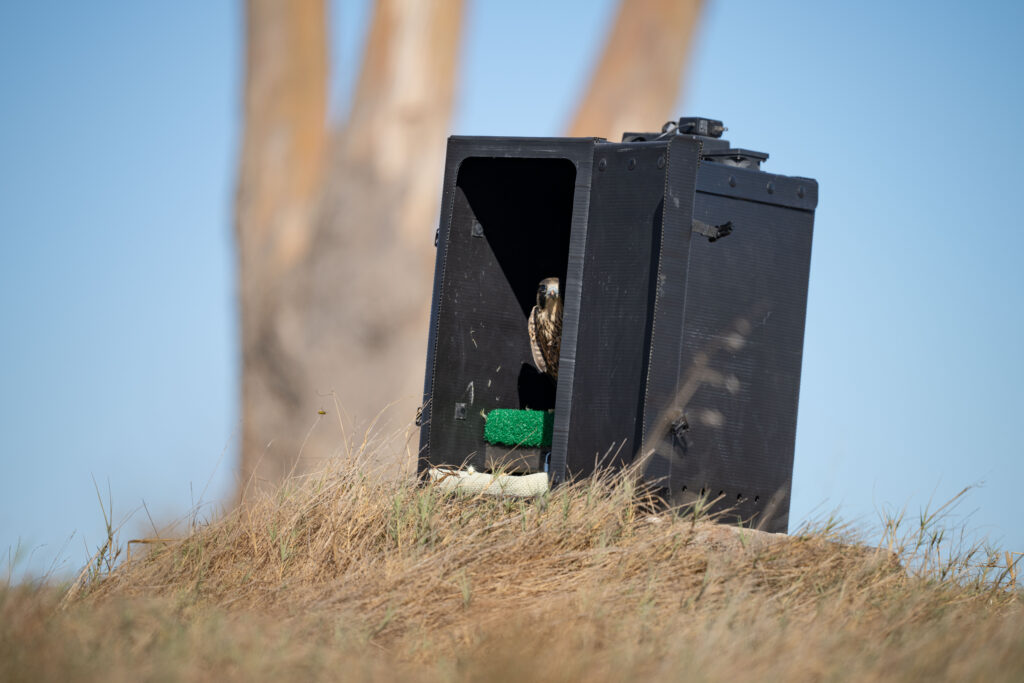
Michael Bannasch/UC Davis
At the park, Nox initially hesitated to fly away. His black transport box sat on the ground, the door open. After five minutes, he remained inside. Meanwhile, a group of well-wishers stood by, including Nox’s UC Davis surgeon, Dr. Hughes Beaufrére, and Cal Falcons raptor expert Mary Malec, who had scouted out the site for any dangers.
In a nearby field, Ferrier tried luring Nox out by swinging an artificial bird on a long cord and whistling.
But in his own time and clutching a thawed quail chick he’d been given, Nox took off, landing in a small tree near a eucalyptus grove. “I’m so very pleased with his strength,” said Malec.
By mid-afternoon, the juvenile had traveled five miles east.
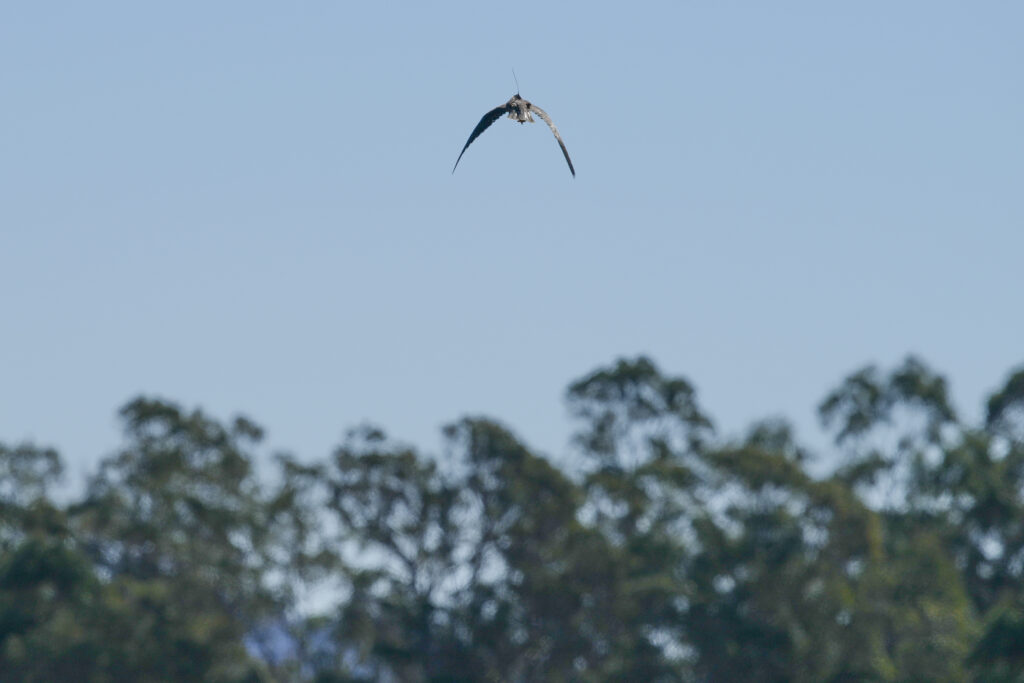
Michael Bannasch/UC Davis
Three months of recovery begin
After his wing surgery, Nox was moved to the California Raptor Center, but not to an aviary, like other birds rehabilitating there. Falcons are “stressy,” said Dr. Michelle Hawkins, the center’s director. “They want to get away from us, they won’t eat sometimes, they bang on the sides of their enclosures trying to get out.
“We consulted with a number of falconers, and… put him in one of those large, soft-sided dog crates, so if he did bounce around, he wouldn’t hurt himself.”
Nox’s medications were long-acting and hidden inside his meals — mice — to reduce the need for human touch. “Falcons like Nox want to be wild, not around humans,” she said.
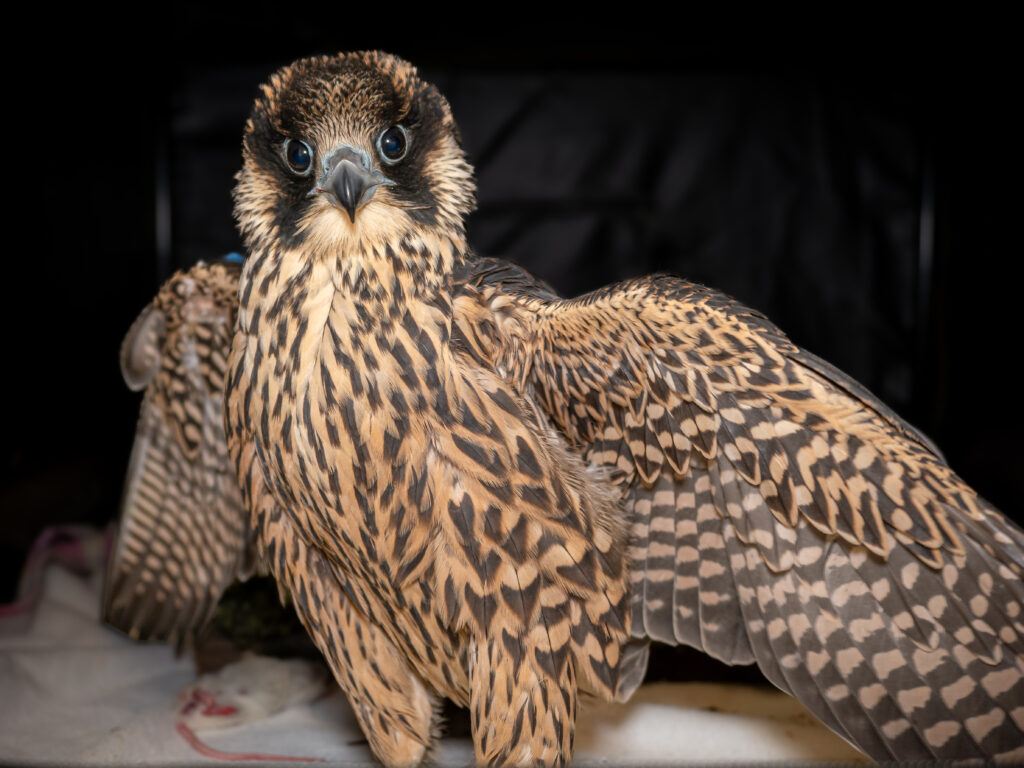
Billy Thein/UC Davis California Raptor Center
In early September, Nox was ready to live and work with a falconer to advance the life skills he was learning before his injury. Ferrier, a falconer since 1967 who had worked with both wild caught and captive bred falcons, took the job.
“With Nox,” said Ferrier, “the biggest challenge was that all wild peregrines have a natural fear of humans. And in Nox’s situation, the poor guy had had a broken wing and anesthesia, surgery and meds delivered to him. Every time this bird was around humans, they were bothering him. Falcons can’t rationalize that they’re being helped.
“I had to help him overcome that experience and make him understand that I wasn’t going to hurt him, and that I’m his friend. That’s what made Nox such a challenge. I spent countless time with him.”
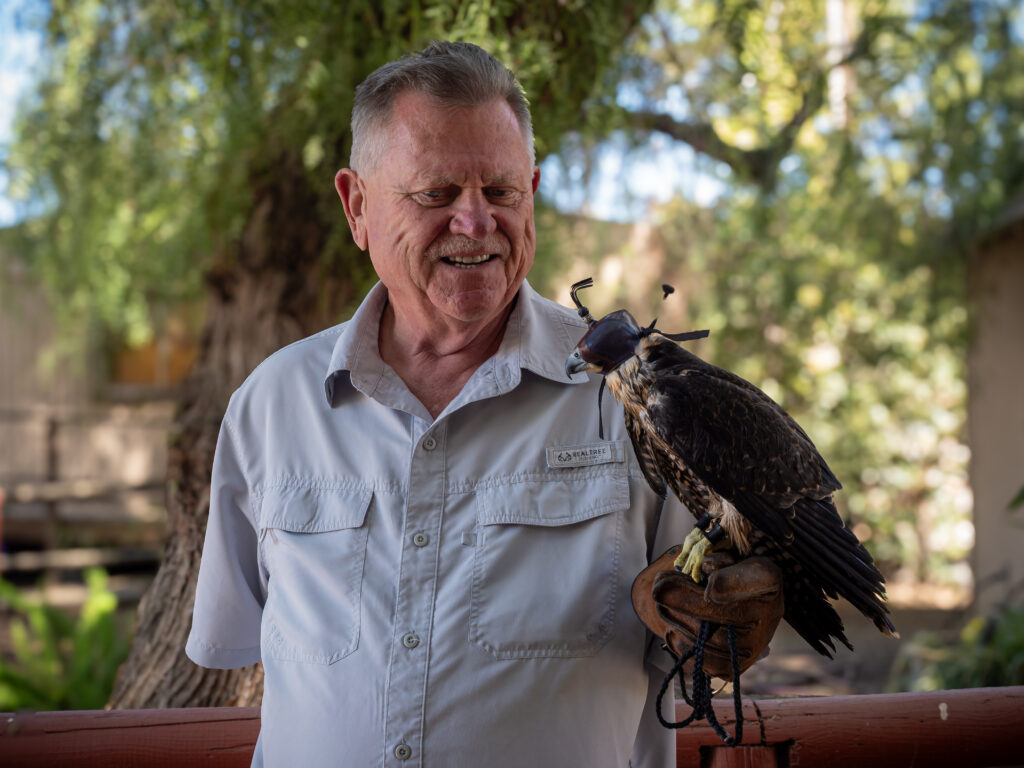
Billy Thein/UC Davis California Raptor Center
A personal trainer and a hood
In the quiet evening hours, Ferrier introduced Nox to a falconry hood, a tool that calms raptors and prevents injury. “I’d hood him sometimes 40 to 50 times a night,” he said, “so he’d get used to it and know I would not hurt him.
“I’d talk to him and get him used to be handled by me, then the hood would go off, then come back on again. I’d intermix that with a treat on my glove, a piece of frozen thawed quail.”
Eventually, Nox began riding peacefully in Ferrier’s truck with two other falcons and even joined the falconer’s household, sitting on a pole in the family room, unhooded, “while we were watching a movie,” said Ferrier. “He got used to my dogs being around, the TV, the sounds, the people.”
In the wild, Ferrier taught Nox to catch prey, releasing pigeons for him to catch, then signaling for Nox to return to his leather falconry glove. A week ago, Nox free flew half a mile, landed on a power pole, then zoomed up to a power transfer tower 200 feet above.
Ferrier released a pigeon and said Nox “came off the tower full speed ahead and pumped his wings hard and chased that pigeon into the bush and captured it.
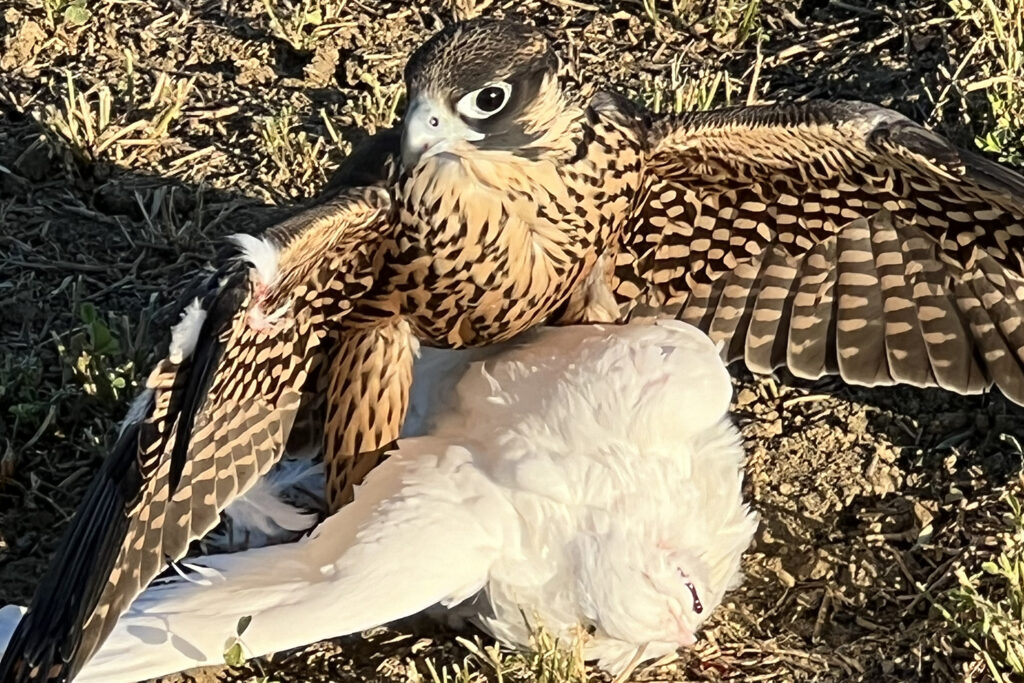
Bill Ferrier/UC Davis California Raptor Center
“From that observation, I can tell you that bird was ready to go. And when these birds are ready to go, they need to be released back into the wild. It’s best for the bird.
“But there were a few caveats, and one was that he’d have to have a backpack on.”
The rare chance to track a young falcon
That backpack — its weight about equal to three U.S. quarters — contains a small, solar-powered GPS transmitter to indicate Nox’s location several times a day. It also provides the air speed, external temperature and voltage level.
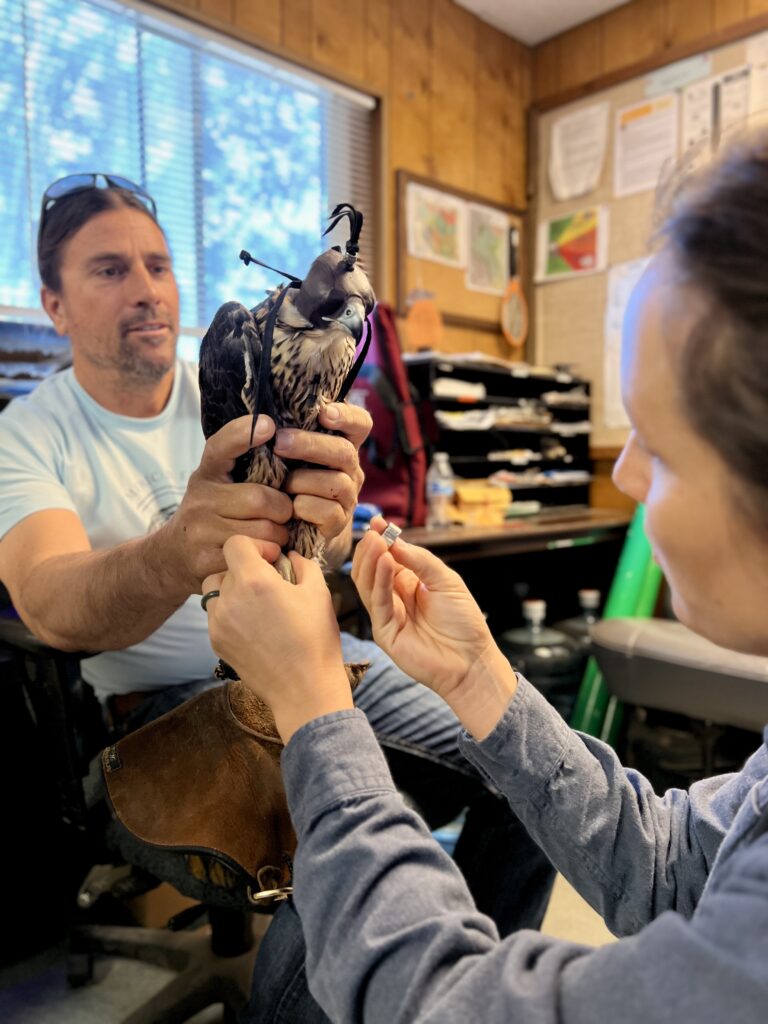
Trina Wood/UC Davis School of Veterinary Medicine
Sean Peterson, an environmental ecologist with Cal Falcons, said Nox’s return to the wild provided a rare opportunity to attach a transmitter to a young falcon. When Nox and his siblings were hatchlings, they were too small to be fitted with such a device.
On Friday, experts from the American Eagle Research Institute, based in Arizona, brought the transmitter backpack to the release site. One of them, biologist Nick Todd, had a permit to attach it to Nox and did so with Ferrier’s help in a trailer provided by the East Bay Regional Park District.
“Any research on wild animals is strictly regulated by state and federal agencies,” said Peterson. “We’re lucky to have contacts with people who are permitted to do this kind of research and aid.”
Zeka Glucs, director of the UC Santa Cruz Predatory Bird Research Group, placed new ID bands on Nox’s legs, as the original ones had been removed for surgery. Each spring, Glucs puts ID bands on Berkeley’s newest falcon chicks.
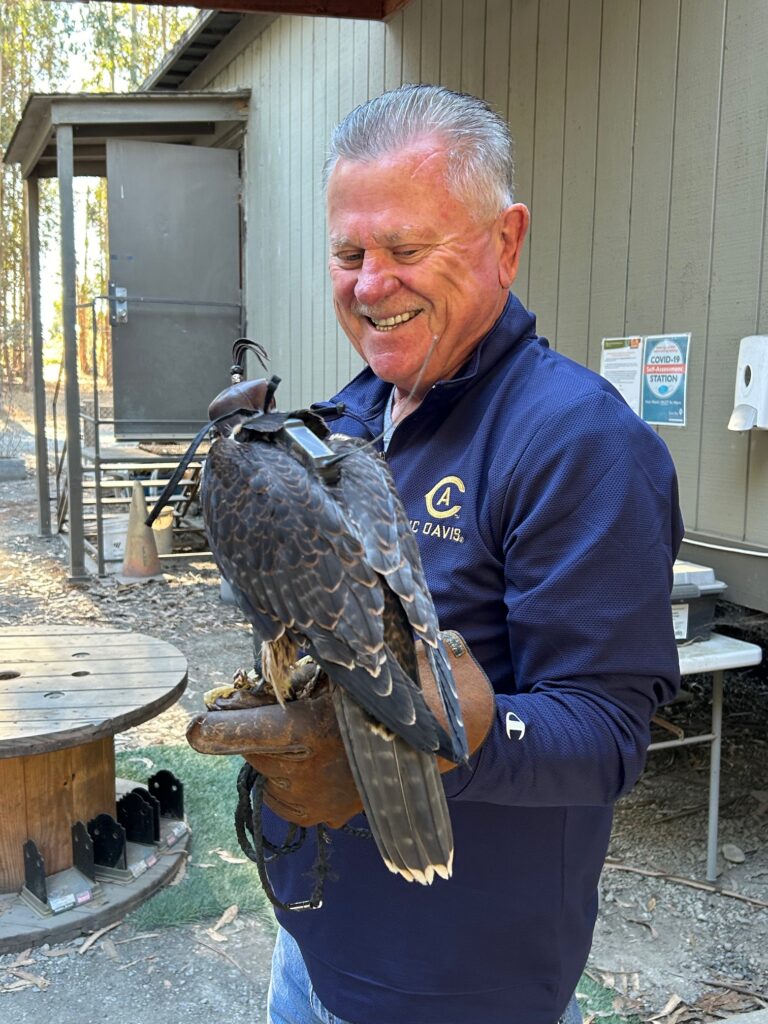
Gretchen Kell/UC Berkeley
For years to come, Nox’s transmitter will give Glucs and Cal Falcons access to data on his whereabouts, said Peterson, adding that studies have shown that these data are collected with minimal impact on the birds.
“They can carry the [backpacks] for a long time without being bothered by them,” he said.
A big question in peregrine falcon research is where young falcons go after they leave their parents’ territories. During the first year of their lives, only about 50% of them survive.
“I can’t wait to see where Nox decides to look for a home of his own,” Peterson said. “Hopefully, the data he provides will help us learn more about what we need to do to conserve the world around us and make it safer for these baby falcons making it on their own for the first time.”